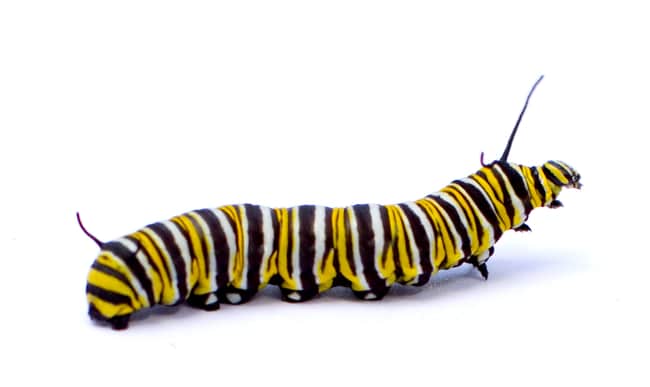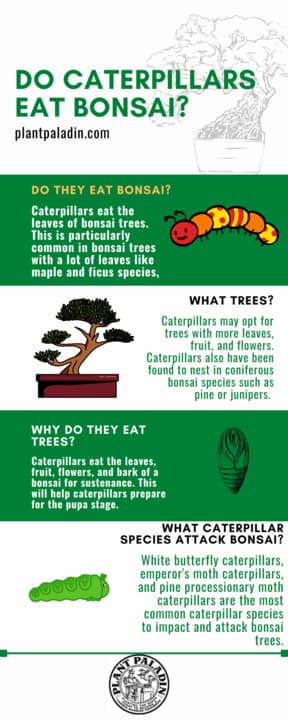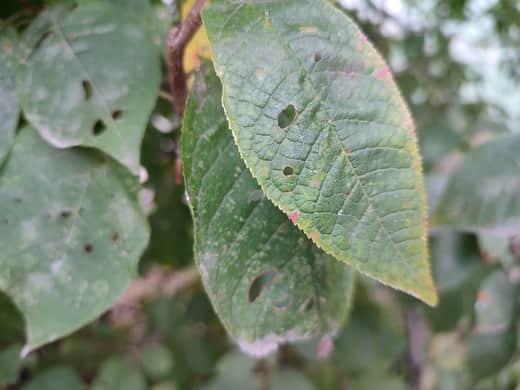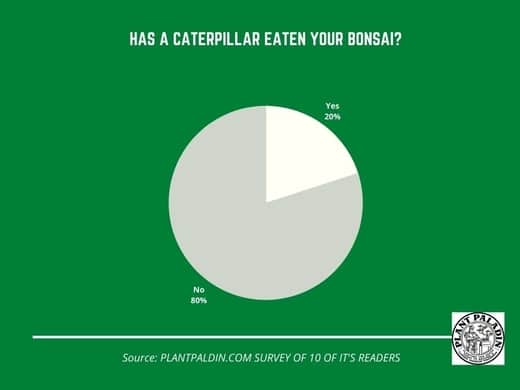This website is supported by its readers. If you click one of my links I may earn a commission. I am also a participant in the Amazon affiliates program and I will also earn a commission from qualified purchases.

Recently I was watering some of the bonsai I keep in my outdoor nursery when I noticed about 3 small caterpillars nesting on some of the leaves in my Chinese elm. This got me thinking, Do caterpillars eat bonsai trees?
Caterpillars eat the leaves of bonsai trees. This is particularly common in bonsai trees with a lot of leaves like maple and ficus species, as well as coniferous species such as pine and juniper bonsai.
So what caterpillar species tend to eat bonsai trees the most? And what happens if you do nothing to address a caterpillar infestation? Keep reading to find out more.
Just a quick heads up, over the past three years of running Plantpaladin, hundreds of people have asked for product recommendations. As such, You can find my favorite indoor bonsai tree here (link takes you to Bonsaiboy), my favorite outdoor bonsai tree (link takes you to Bonsaiboy), or have a look at all the products I recommend here.
Do bonsai trees eat caterpillars?
As bonsai owners, we are all too aware of some of the pests that can commonly attack our trees.
It’s all too common for aphids, spider mites, scale, slugs, and all manner of insects to attack bonsai.
Even larger animals like birds and frogs have also been known to nest or eat bonsai trees.
One insect however a lot of bonsai owners forget about are caterpillars.
So do caterpillars eat and attack bonsai trees?
Well after asking 10 plant paladin readers, visiting my local botanical gardens and speaking with an expert, and even having to deal with a few caterpillars in my own bonsai collection, I came up with the following:
- Caterpillars will eat bonsai trees.
- In particular, caterpillars will often eat the leaves of bonsai but have also been observed to eat the fruit, flowers, and bark of bonsai
- Bonsai trees than with dense canopies or a lot of ramification and leaves are likely to be at higher risk from caterpillars the other bonsai
- Trees that also bare a lot of fruit such as crab apple or lime or bonsai that flower such as azalea will also have a higher chance of being attacked and eaten by caterpillars
- If left unchecked a few caterpillars can strip and damage a bonsai – impacting its ability to photosynthesize.
- To avoid caterpillars eating bonsai, use a pesticide containing Bacillus thuringiensis which is more effective than traditional pesticides used for other insects.

How to tell if caterpillars are eating bonsai?
So now we know that caterpillars can eat bonsai trees, what are some surefire signs to keep an eye out for to deduce if your bonsai trees are getting eaten and damaged by caterpillars?
These include:
- Holes in the leaves of your bonsai
- Caterpillar frass
- Missing edges from the leaves
- More insects around your bonsai
- Increased bird activity near your tree
Let’s explore these in more detail:
Holes in the leaves of your bonsai
Easily the most common symptom that you have a caterpillar infestation is if there are holes in the leaves of your bonsai.
Whilst caterpillars eat all parts of bonsai trees, more often than not it will be the leaves that get the largest brunt.
If then you notice large holes in the leaves of your bonsai then it can be a surefire sign you have a caterpillar infestation.

Caterpillar Frass
Caterpillar frass is just caterpillar poop that will be deposited in and around your bonsai.
If then you find a lot of tiny brown droppings on the leaves of your bonsai tree then that can be a sign you have a caterpillar nesting and eating your tree.
These can be hard to spot however and it’s worth noting to always look under the leaves of your bonsai for these signs too.
Missing edges on your leaves
Another major sign you have caterpillars eating your bonsai is if the edges of your bonsai leaves are not straight.
For most deciduous species like maples or Chinese elms, the leaves of your Bonsai will typically have a nice round structure to them.
If then you find that these are a little more jaggedy than the rest of the leaves then it could be assumed that caterpillars are eating your bonsai.
This will typically be easier to find on deciduous trees as opposed to coniferous trees which usually have needle-like leaves and can be more difficult to spot.
More insects around your bonsai
If you have an increased number of insects such as aphids, ants, or other creepy crawlies around your bonsai it could be a surefire sign that you also have caterpillars in your tree.
Caterpillars are prey to a large number of insects.
Should there be an ample food source in the form of insects and around your tree, it can act as its own little micro-ecosystem, which will also attract caterpillars.
Now bugs can be incredibly damaging to bonsai trees so check out this post on how to remove them from your bonsai tree or check out the infographic below:

Increased bird activity
Similar to the point I mentioned above, birds also feed on caterpillars, in fact for most birds, worms and caterpillars make up a large proportion of their food.
As such if you notice an increased amount of birds around your bonsai, and not just typical blackbirds, crows, and ravens that usually attack bonsai but smaller birds such as blue tits, then you might find that your bonsai tree has signs of caterpillar infestation.
How to remove caterpillars from bonsai?
Luckily like other insect types, there are a few methods that you can follow to remove caterpillars from your bonsai.
These include:
- Manually removing the caterpillar
- Using a pesticide
- Using predatory bugs
- Blasting with water
- Remove any infested branches
- Keep your bonsai indoors
Manually remove the caterpillar
So one of the easiest methods to remove caterpillars from your bonsai is simply to manually remove them.
This will be a lot easier to do in smaller-sized bonsai such as fingertip bonsai as the caterpillar will only have so much room to move around in.
To do this then inspect all aspects of your bonsai including under the leaves of your tree for signs of caterpillars.
This can be difficult as a lot of caterpillars are the same color as the trees they inhabit with some even going so far as to camouflage.
My recommendation is to wear a pair of disposable gloves and invest in a small magnifying glass that will allow you to inspect the leaves of your bonsai thoroughly.
I’d also recommend checking your bonsai soil when repotting your tree.
Bonsai soil is usually made of inorganic material to help the moisture flow.
As such it can have tiny air pockets that caterpillars can burrow in.
This can happen if caterpillars crawl up into your tree from the drainage holes in your bonsai pot.
Finally, if you also keep a lot of mosses near your bonsai such as sphagnum moss then you might also want to check these thoroughly as caterpillars often eat many kinds of mosses.
Using a pesticide
Now if your caterpillar problem is more serious than just one or two caterpillars the next option will be to invest in a good pesticide.
Now whilst most pesticides are super effective against most insect types, it’s worth noting that some of these won’t be as effective against caterpillars.
As such you want to make sure that any pesticide that you use to get rid of the caterpillars in your bonsai contains Bacillus Thuringiensis which will disrupt and destroy the digestive system of caterpillars.
Now caterpillars rarely rest just in the leaves on your bonsai but can also dig their way inside the bark or in small cracks on the branches of your tree.
If this is the case you may need to use a pesticide spray and soak it in with a cotton bud or a flexible syringe in order to ensure you get the right coverage.
Use predatory bugs
If you want to stay away from chemical pesticides another fantastic option would be to use predatory insects.
Ladybugs also known as lady beetles are a fantastic option to use on nighttime feeding caterpillars. Simply add two to three to your bonsai and they will feed on the caterpillars without damaging your plant.
Another fantastic option would be wasps although trying to control these may prove more challenging than ladybugs.
Blasting your bonsai with water
Another great natural option to use against caterpillars is to simply blast them with a high-pressure water stream.
This works best when used from a pressure washer and will literally blast them off the surface of your bonsai if they are nested on the leaves of your tree.
Hot water works best if possible.
To avoid any caterpillars that are nesting in any crack of your bonsai or other hard-to-reach places this method also works particularly well.
Just be sure that your bonsai pot has good drainage holes to avoid overwatering.
Remove any infested branches
Should the caterpillars in your bonsai be nested in the buds of your bonsai or in small cracks in your tree and the caterpillar infestation is too much a good option would be to remove the branches or buds.
This will stop the caterpillar problem from your tree from spreading.
You can then take this one step further and defoliate the leaves of your bonsai.
This will remove all the leaves of your tree and remove the caterpillar’s primary food source.
Keep your bonsai indoors
Finally, it might sound a little obvious but a surefire way to ensure your bonsai tree does not get eaten by caterpillars is to move it indoors.
Whilst caterpillars can thrive indoors, it is very rare that caterpillars make it all the way indoors by their own accord and so moving your bonsai indoors will mean that you can prevent any insects from getting near them.
Just ensure your bonsai tree gets enough sunlight when keeping them indoors to maintain its health.
What types of bonsai trees do caterpillars eat?
Caterpillars will eat any species of bonsai. In particular, however, caterpillars may opt for trees with more leaves, fruit, and flowers. Caterpillars also have been found to nest in coniferous bonsai species such as pine or junipers.
Why do caterpillars eat bonsai?
Caterpillars eat the leaves, fruit, flowers, and bark of a bonsai for sustenance. This will help caterpillars prepare for the pupa stage. Bonsai trees in particular have a variety of different food types making a bonsai tree the perfect habitat for a growing caterpillar.
Do caterpillars nest in bonsai?
Smaller-sized caterpillars have been found nesting in small cracks in the branches of bonsai trees or in the buds of bonsai trees. Some caterpillars will also burrow through the topsoil of your bonsai to rest in the soil of the tree.
Are caterpillars dangerous for bonsai?
Caterpillars can cause serious damage to bonsai trees by eating the leaves of trees that are essential for the photosynthesis process. Caterpillars can also attract predators such as birds and slugs to your tree which can further cause damage to your tree.
What caterpillar species attack bonsai?
White butterfly caterpillars, emperor’s moth caterpillars, and pine processionary moth caterpillars are the most common caterpillar species to impact and attack bonsai trees.
How much bonsai do caterpillars eat?
Large caterpillars eat around one large leaf per day for sustenance. Ten to fifteen caterpillars then can eat the entire canopy of a bonsai tree within a week. Caterpillars may also eat the bark and fruit of a bonsai tree.
Are there any benefits of having caterpillars near bonsai?
Whilst caterpillars can be damaging to bonsai trees, when they evolve into moths or butterflies, they can prove to be beneficial by pollinating your tree helping bloom the flowers and fruit.
When do caterpillars eat bonsai?
Many caterpillars are nocturnal and so will feed on bonsai trees during nighttime. Most caterpillars live for about 2 to 5 weeks during the early spring months and so they often infect bonsai trees, right at the start of the growing season.
What do the experts say?
Finally, I didn’t just want to give my opinion but wanted to get a couple of other opinions on caterpillars and bonsai trees.
First I visited my local botanical gardens and asked them about caterpillars and bonsai trees, this is what they said:
“Caterpillars like any pest need to be taken care of so to not damage bonsai trees”
I also did a quick survey of ten plant paladin readers asking them their thoughts on if caterpillars eat bonsai trees and here are the results:

A lot of you reading this are relatively new to the world of bonsai and so I wanted to share some posts that I think are essential reading for beginners:
- Bonsai repotting aftercare
- Bonsai trees and rainwater
- Why are bonsai pots expensive
- Why are bonsai pots shallow?
- How to find the age of my bonsai?
- Do bonsai trees smell?
- How to fuse bonsai trunks
My top picks for the gear you will need!
So like I mentioned earlier, over the past three years of running PlantPaladin, hundreds of people have asked me for my recommendations on the best bonsai gear on the market.
Having spent thousands of dollars on bonsai items these past few years and tested at least 100 bonsai-specific products, I’ve listed my favorite products below – All of which I highly recommend and think you can get great value.
They can purchase directly by clicking the link to take them to Amazon.
Bonsai Tool Set: One of the significant challenges I’ve had is finding a toolset that was not only durable but didn’t break the bank. SOLIGT has recently developed a fantastic bonsai tool set that covers all the tools you need to trim, prune, and repot your trees. – You can grab it here.
Complete Bonsai Set: Many of you will want to grow your bonsai trees entirely from scratch, but finding the varicose seeds, pots, and other items in one place can be challenging. Leaves and Sole then have created a complete bonsai set that I’ve personally used that ticks all the boxes. You can grab it here.
Bonsai wire: The number of times I’ve run out of wire for my bonsai or purchased cheap bonsai wire that doesn’t do the job is embarrassing for me to admit. After a lot of trial and error, I found that using Hotop’s aluminum bonsai wire is one of the best options on the market. This can easily be used for both indoor and outdoor bonsai. You can grab it here.
This post was written by Fehed Nicass who has been passionate about bonsai for over 2 years.
